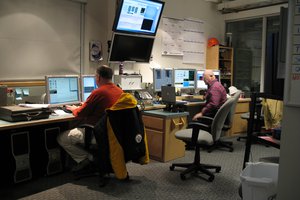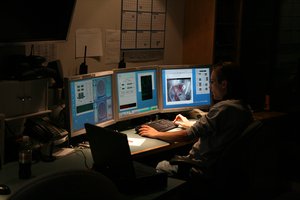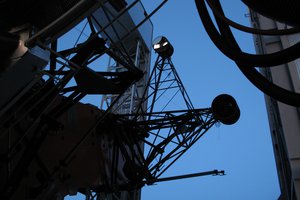Observing with the LBT
The Large Binocular Telescope is equipped with a suite of world class instruments covering a wide a range of applications in both the optical and near-IR wavelength ranges.

Observer and Telescope Operator at work
Credit: AIP
The Telescope Operator at work
Credit: AIP
The LBT opening up for the night.
Credit: AIPAny AIP affiliated scientist or student can apply for observing time with the LBT following the instructions given in the Call for Proposals which is issued twice a year. The proposals which are submitted will then be evaluated by the AIP LBT Time Allocation Committee which prepares a ranked list of the proposals as a recommendation for the Scientific Chair. The successful proposals are then granted status as either A (highest priority) or B (lower priority) and submitted to the German observation coordinator for execution at the telescope. The German partners put together a team of observers which will then carry out the observations in a given observing run (typically one week long). The team consists of astronomers from different German partner institutes.
The Principal Investigator for an accepted program will have to prepare so called phase-II material containing detailed instructions for the observers on how the observations should be carried out. This includes observing scripts for the instruments as well as a detailed readme file describing the particular issues regarding the observing program. Detailed information is available in the various instrument manuals available from the LBT Observers Reference Page as well as from the LBTO science operations pages where late news and changes will be made available. At this stage it is very important to clarify any technical or astronomical questions which are relevant to the observations so the observers have the complete information to decide when and how to execute the program at the telescope. It is thus very important to ask any questions which the manual does not provide a straight forward answer for. One can ask experienced colleagues but is also encouraged to ask the instrument scientists in Tucson who have extensive experience with the instruments. They can be contacted by e-mail or phone, see the science support page. If you use the generic e-mail address given there you are sure that somebody will respond soon, this can of course not be guaranteed if you use one of the personal e-mail addresses.
When an observing run has been completed the scientific data will be transferred to the LBT archive in Tucson from where the data can be requested.
As a partner the AIP also provides observers for the German observing runs. We send both experienced observers and students to the LBT.
For more information contact: Jesper Storm